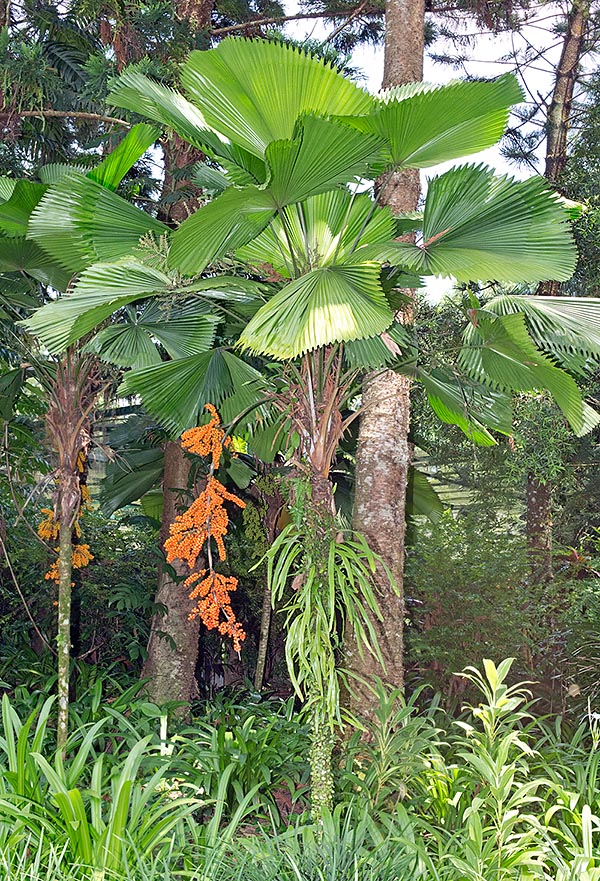Family : Arecaceae

Text © Pietro Puccio

English translation by Mario Beltramini

Very ornamental, Licuala grandis is native to Santa Cruz and Vanuatu Islands © Giuseppe Mazza
The species is native to the islands of Santa Cruz and Vanuatu where it grows in the pluvial forests mainly along the water streams, at low altitudes.
The name of the genus comes from the local name “leko wala” given to this genus of palms in the Maluku Islands; the name of the species is the Latin adjective “grandis” = big, with obvious reference.
Common names: ruffled fan palm, Vanuatu fan palm (English); palmier-cuillère, palmier éventail de Vanuatu (French); palmeira-leque, licuala-grande, palmeira-liquala (Portuguese-Brazil); licuala grande, palma abanico de Vanuatu, totuma (Spanish); Großblättrige Strahlenpalme (German).
The Licuala grandis H.Wendl. (1880) is a slow-growing monoecious solitary species, up to 3 m tall, with thin, erect stem of 5-8 cm of diameter, covered by the remnants and by the brown fibres of the bases of the petioles. The leaves, on an up to 1 m long petiole armed at the margins, up to about half of its length, by curved thorns, are almost circular, up to about 90 cm of diameter, undivided, plicate, toothed at the apex, waved, of bright green colour. The inflorescences, ramified of the third order, come out between the leaves, up to more than 1 m long, with hermaphroditic flowers spirally arranged, 5 mm long and of 3 mm of diameter, of yellowish white colour. The fruits are globose, of 0,8-1,2 cm of diameter, reddish orange to bright red when ripe, containing one only seed of 0,4-0,6 cm of diameter.
It reproduces by seed, previously kept in water for two days, in organic loam, aerated and draining, maintained humid at the temperature of 26-28 °C, with variable germination times, usually from 1 to 6 months; the first leaflet is simple, plicate, toothed at the margin.
Species of great ornamental and landscaping effect in parks and gardens, as single specimen and even more in group, due to the big entire plicate leaves, the thin stem and the long coloured infructescences, cultivable in the tropical climate zones and marginally subtropical, where temperatures of less then +10 °C are exceptional events and of very short duration, characterized by high and constant atmospheric humidity. It prefers a semi-shaded position, even if, when adult, it can bear the full sun if the humidity if high, sheltered from the wind which would damage the leaves, and well draining soils rich of organic substance, acidic to slightly alkaline, constantly humid; in the climates with long dry periods it is to be positioned in the shade and regularly and abundantly watered.
Thanks to the relatively contained dimensions and the slow growth it is particularly appreciated as plant in pot, utilizing a draining and aerated loam rich of organic substance maintained constantly humid, for the decoration of open spaces, where the climate allows so, or of greenhouses, verandas and winter gardens in luminous and away from drafts, with high values of ambient humidity and of diurnal temperatures, best 24-28 °C, and lowest night ones not under the +16 °C. The fertilizations are to be done once a month, from spring to autumn, with hydrosoluble balanced products, with microelements, at half dosage than what suggested on the package.
Synonyms: Pritchardia grandis (H.Wendl.) W.Bull (1874).
→ For general notions about ARECACEAE please click here.
